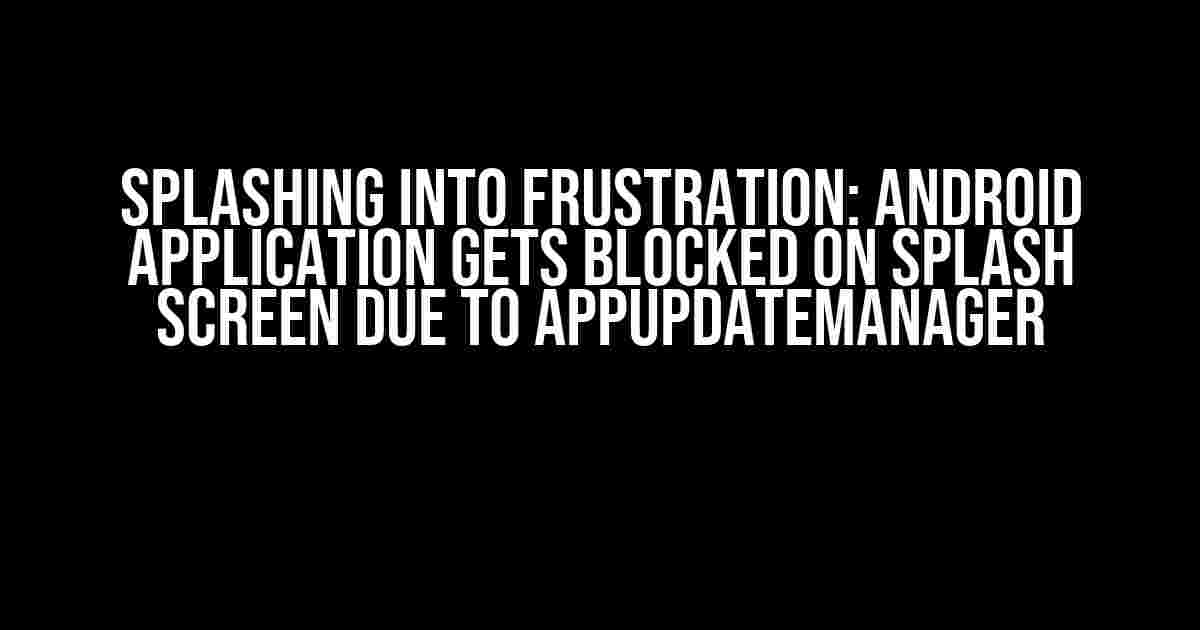Oh, the sweet taste of disappointment! You’ve spent hours crafting the perfect Android app, only to see it get stuck on the splash screen. The culprit? The infamous AppUpdateManager. Don’t worry, friend, we’ve got your back! In this comprehensive guide, we’ll delve into the world of AppUpdateManager, diagnose the issue, and provide you with actionable solutions to get your app up and running in no time.
What is AppUpdateManager, anyway?
The AppUpdateManager is a powerful tool introduced by Google in Android 10 (API level 29) to help developers manage app updates more efficiently. It allows users to update their apps in the background, ensuring a seamless experience. However, this blessing can quickly turn into a curse if not implemented correctly.
The Problem: Stuck on Splash Screen
When your app is stuck on the splash screen due to AppUpdateManager, it’s usually because of one of the following reasons:
UPDATE_PRIORITY_HIGHis set, causing the app to wait for the update to complete before proceeding.- The app is trying to update while the user is interacting with the splash screen.
- There’s an issue with the update itself, preventing the app from completing the update process.
Diagnosing the Issue
To identify the root cause of the problem, follow these steps:
Logcatis your best friend! Check the logcat output for any errors or warnings related to AppUpdateManager.- Verify that you’re using the correct
UPDATE_PRIORITYvalue. If you’re usingUPDATE_PRIORITY_HIGH, try switching toUPDATE_PRIORITY_DEFAULT. - Check your app’s update logic to ensure it’s not interfering with the splash screen.
Solution 1: Update Priority
One of the most common causes of the splash screen issue is the UPDATE_PRIORITY_HIGH setting. To fix this, simply change the update priority to UPDATE_PRIORITY_DEFAULT. Here’s an example of how to do it:
AppUpdateManager manager = AppUpdateManagerFactory.create(context);
manager.setUpdatePriority(UpdatePriority.DEFAULT);
Solution 2: Disable Update on Splash Screen
Another approach is to disable the update process while the user is interacting with the splash screen. You can achieve this by checking if the app is currently on the splash screen and temporarily disabling updates:
if (isSplashScreenVisible()) {
manager.disableUpdate();
} else {
manager.enableUpdate();
}
Solution 3: Handle Update Failure
In some cases, the update process might fail due to various reasons, such as network connectivity issues or corrupted APK files. To handle update failures, you can use the AppUpdateManager.OnCompleteListener interface to detect and retry the update process:
manager.registerListener(new AppUpdateManager.OnCompleteListener() {
@Override
public void onComplete(int status) {
if (status == AppUpdateManager.UPDATE_NOT_AVAILABLE) {
// Retry the update process
manager.retryUpdate();
}
}
});
Best Practices for AppUpdateManager
To avoid the splash screen issue altogether, follow these best practices when implementing AppUpdateManager:
| Best Practice | Description |
|---|---|
Use UPDATE_PRIORITY_DEFAULT |
Avoid using UPDATE_PRIORITY_HIGH unless necessary, as it can cause the app to wait for the update to complete. |
| Disable updates on splash screen | Temporarily disable updates while the user is interacting with the splash screen to prevent interference. |
| Handle update failures | Implement a retry mechanism to handle update failures and ensure the app remains functional. |
| Test thoroughly | Test your app’s update logic and AppUpdateManager implementation to catch any potential issues before release. |
Conclusion
Getting stuck on the splash screen due to AppUpdateManager can be frustrating, but with the right tools and knowledge, you can overcome this hurdle. By diagnosing the issue, implementing the solutions provided, and following best practices, you’ll be able to provide a seamless experience for your users. Remember, a well-implemented AppUpdateManager is key to a successful Android app.
Happy coding, and may your app never get stuck on the splash screen again!
Frequently Asked Question
Get unstuck with AppUpdateManager! Here are the answers to your burning questions about Android applications getting blocked on the splash screen.
Why does my Android app get stuck on the splash screen due to AppUpdateManager?
AppUpdateManager is a built-in Android library that helps manage app updates. However, if not implemented correctly, it can cause your app to get stuck on the splash screen. This usually happens when the AppUpdateManager is initialized too early in the app’s lifecycle, causing a deadlock.
How can I identify if AppUpdateManager is causing the issue in my app?
Check your app’s logcat for any error messages related to AppUpdateManager. You can also use Android Studio’s debugger to identify the point where your app gets stuck. If you’re using a third-party library, check their documentation for any known issues related to AppUpdateManager.
Can I disable AppUpdateManager to resolve the issue?
Disabling AppUpdateManager is not recommended, as it’s an essential component for managing app updates. Instead, focus on implementing it correctly in your app. You can try delaying the initialization of AppUpdateManager until after the splash screen has finished loading.
How do I implement AppUpdateManager correctly in my Android app?
To implement AppUpdateManager correctly, make sure to initialize it in the AppCompatActivity’s onCreate() method, after the super.onCreate() call. Also, ensure that you’re not blocking the UI thread while checking for updates.
Are there any alternative libraries available for managing app updates in Android?
Yes, there are alternative libraries available, such as Firebase App Distribution and Google’s Play Core Library. These libraries provide more flexibility and features for managing app updates. However, it’s essential to evaluate their compatibility and feasibility for your specific use case.
I hope this helps you troubleshoot and resolve the issue with AppUpdateManager in your Android app!
